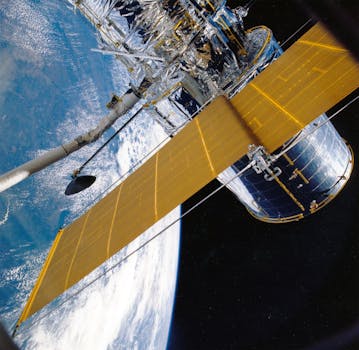GEO Satellites: Introduction to the Focus Keyword
GEO satellites, or Geostationary Earth Orbit satellites, are a type of satellite that orbits the Earth at an altitude of approximately 36,000 kilometers, remaining stationary relative to a fixed point on the equator. The Focus Keyword: GEO satellites have been in use for several decades, providing a wide range of applications and services, including telecommunications, weather forecasting, and navigation. The technology behind GEO satellites is complex and involves a deep understanding of orbital mechanics, spacecraft design, and communication systems.
How GEO Satellites Work
GEO satellites work by transmitting and receiving signals to and from Earth stations, which are typically located on the ground. The signals are transmitted through a large antenna, which is pointed towards the satellite. The satellite then amplifies the signal and retransmits it back to Earth, where it is received by another Earth station. This process allows for communication between two distant points on the Earth’s surface, enabling global coverage and connectivity. The use of GEO satellites has revolutionized the field of telecommunications, enabling the transmission of data, voice, and video signals over long distances.
Applications of GEO Satellites
GEO satellites have a wide range of applications, including telecommunications, weather forecasting, and navigation. In the field of telecommunications, GEO satellites are used to provide mobile network coverage, broadband internet, and television broadcasting. They are also used for military communications, navigation, and remote sensing. The use of GEO satellites has enabled the development of global navigation systems, such as GPS, which provide location information and timing signals to users around the world.
Advantages and Challenges of GEO Satellites
GEO satellites have several advantages, including global coverage, high bandwidth, and long-term reliability. They are also relatively low-cost compared to other types of satellites, such as Low Earth Orbit (LEO) satellites. However, GEO satellites also have several challenges, including signal latency, interference, and orbital congestion. The signal latency, which is the delay between the time a signal is transmitted and the time it is received, can be significant, typically around 250-300 milliseconds. This can be a problem for applications that require real-time communication, such as video conferencing.
Future of GEO Satellites
The future of GEO satellites is exciting, with several new developments and technologies on the horizon. One of the most significant trends is the development of High-Throughput Satellites (HTS), which offer much higher bandwidth and capacity than traditional GEO satellites. HTS are designed to provide high-speed internet and broadband services, and are expected to play a major role in the development of 5G networks. Another trend is the use of advanced propulsion systems, such as electric propulsion, which are more efficient and reliable than traditional chemical propulsion systems. These new technologies are expected to enable the development of more powerful and capable GEO satellites, with a wide range of applications and services.
